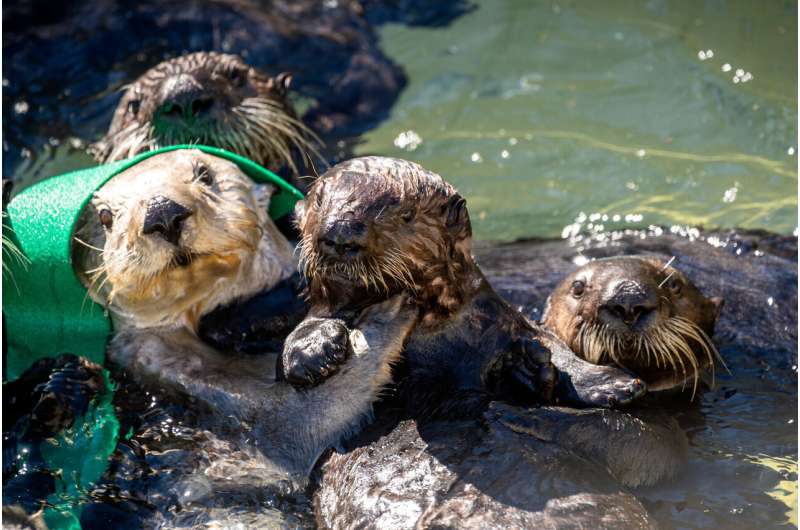This article has been reviewed according to Science X's editorial process and policies. Editors have highlighted the following attributes while ensuring the content's credibility:
fact-checked
peer-reviewed publication
trusted source
proofread
New study shares the intimate details of sea otter surrogacy, affirms its effectiveness to rehabilitate orphaned pups

Monterey Bay Aquarium provides insights on the best practices for releasing orphaned southern sea otter pups to the wild in a new study. The study affirms the effectiveness of the Aquarium's innovative sea otter surrogate-rearing methods, and finds the primary factors affecting individual sea otters' abilities to reacclimate to the wild occurred after release.
Published today in the journal Biological Conservation, the paper, "Advancing Surrogate-rearing Methods to Enhance Southern Sea Otter Recovery," examines the Aquarium's surrogacy rehabilitation and release program and identifies key components that contribute most to a sea otter's success upon release.
Monterey Bay Aquarium developed and pioneered the sea otter surrogacy program, which pairs young otter orphans with non-releasable female adult otters who bond with and care for the pups as their own. Aquarium researchers initiated the study to optimize the program's methods and contribution to the recovery of this threatened species.
"These findings describe everyday life-threatening challenges experienced by sea otter pups,and help us identify optimal conditions for returning orphaned otters to the wild, where they may benefit population and ecosystem recovery," said lead author Teri Nicholson, Senior Research Biologist for Monterey Bay Aquarium's Sea Otter Program. "Because of our surrogate females' strong nurturing behavior, three-quarters of the orphaned pups in our program reacclimate to the wild after release. What we are learning from this study will increase this success."
Nicholson and her colleagues examined 20 years of surrogate-rearing methods for 64 sea otter pups that stranded along the California coastline and were subsequently released as juveniles. The team tracked 34 key rehabilitation and release components to determine what modifications would contribute most to improving successful outcomes in the wild. These results will inform decisions about when and where sea otters may be released within the species' historical range to maximize their chances for survival.
"By sharing more details about sea otters within our program, and our common challenges, we hope to inspire stronger connections with these wildlife populations and stewardship of our shared ocean environment," Nicholson said.
This study also provides a foundation for the expansion of the surrogacy program to other aquariums, including the Aquarium of the Pacific in Long Beach, Calif. The Aquarium of the Pacific joined the surrogacy program in 2020 and has been building a specialized area for pairing stranded sea otter pups with surrogate mothers.
The study highlights the following key conclusions:
- Surrogacy draws from the natural behavior and adaptability of sea otters, resulting in 75% success reacclimating orphans to the wild, regardless of their stranding age, origin, early development, surrogate mother idiosyncrasies, weaning age, and pre-release conditioning.
- Release conditions—such as favorable seas and mild weather– represented the strongest modeled drivers of success.
- Low daily swimming distances by released individuals, and less competitive local population dynamics were additional factors that contributed to success.
- Comparable success rates among a variety of sites and habitats, such as estuary seagrass meadows and open-coast kelp forests, demonstrate the potential for broader application of these methods throughout California, where release conditions are favorable.
The results of this study also may have broader applications for the recovery of other threatened and endangered species and provide a blueprint for nature-based solutions that strengthen ecosystem resilience in the face of increasing impacts from climate change.
"Our surrogacy program is effective, and results from this study build our confidence that we'll be able to increase the number of animals we can return to the wild through key partnerships," said Jess Fujii, Monterey Bay Aquarium's Sea Otter Program Manager. "The study also provides valuable insights for when and where we can release rescued otters with the best chance of success."
More information: Teri E. Nicholson et al, Advancing surrogate-rearing methods to enhance southern sea otter recovery, Biological Conservation (2023). DOI: 10.1016/j.biocon.2023.109962
Journal information: Biological Conservation
Provided by Monterey Bay Aquarium



















